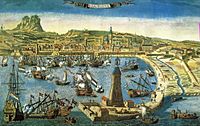Barcelona Trading Company facts for kids
 |
|
| Public company | |
| Industry | Trade |
| Fate | Dissolved |
| Successor | Royal Company of the Philippines |
| Founded | 1755 |
| Defunct | 1785 |
| Headquarters | , |
|
Area served
|
Catalonia, Caribbean |
| Products | cotton, cocoa, indigo, brandy, wine, chintz |
| Total equity | 1 million pesos |
The Barcelona Trading Company (also known as the Real Compañía de Comercio de Barcelona a Indias in Spanish) was a special trading company. It was started in 1755 by the King of Spain. This company had a special right, called a monopoly, to trade with certain Spanish lands in the Caribbean Sea. These lands included Puerto Rico, Hispaniola (which is now Haiti and the Dominican Republic), and Margarita Island.
This company helped merchants from Catalonia (a region in Spain) to trade directly with the Americas. Before this, most trade had to go through a single port, Cádiz. The Barcelona Trading Company helped Catalonia's economy grow. It also played a part in developing the textile industry there. This industry later became very important for Catalonia's growth. In 1785, the company joined with another one to form the Royal Company of the Philippines.
Contents
Why the Company Started
For a long time, since 1503, all trade between Spain and the Americas had to go through the port of Seville. Later, after 1717, it was through Cádiz. This rule meant that other cities, like Barcelona, could not trade directly with the Americas.
However, by the late 1600s, some goods from Catalonia started reaching the Americas. They went by ship to Cádiz first, then across the ocean. By the mid-1740s, ships from Barcelona were starting to sail directly to the Americas.
New Trading Companies
The Barcelona Company was one of several special trading companies. The Spanish government created these in the 1700s. This was part of a plan called the Bourbon Reforms. The goal was to improve Spain's trade with its American colonies. They also wanted to stop British, French, and Dutch smugglers.
These new companies had special trading rights. They were similar to the big trading companies from England, the Netherlands, and France. Other Spanish companies included the Royal Guipuzcoan Company of Caracas and the Havana Company.
What the Company Traded
The Barcelona Trading Company had a special right to trade with the Caribbean islands. These included Puerto Rico, Hispaniola (Santo Domingo), and Margarita Island. They could also make ten trips a year to Guatemala and Honduras. They also traded a bit with Cumaná in Venezuela and Havana in Cuba.
Goods Exported and Imported
The company mainly sent wine and brandy from Spain. They also sent more and more chintz. Chintz was a type of printed cotton fabric made in Barcelona.
The company brought back many products from the Americas. These included raw cotton, indigo (a blue dye), brazilwood, cocoa, tobacco, and sugar. The raw cotton and dyes were used to make more chintz in Spain. This chintz was then sold back to the Americas or in Spain. This trade helped connect Spanish factories with colonial markets.
End of the Company
In 1778, King Charles III signed a new law. It was called the 'Decree of Free Trade'. This law removed the Barcelona Company's special trading rights. It meant other Spanish ports could now trade freely with the Americas.
The company also lost many of its ships. This happened because Spain got involved in the American Revolutionary War. The company was officially closed between 1784 and 1785. It then joined with the Caracas Company. Together, they formed a new company called the Royal Philippine Company.
What the Company Left Behind
The Barcelona Trading Company helped Spanish merchants. It gave them a way to gather money and break free from the old trading rules. It also helped create the right conditions for free trade with the colonies later on.
The company helped focus Catalonia's economy on trade with the Americas. It also helped people learn about trading across the Atlantic. Merchants became used to long ocean voyages.
The trade with the Americas also helped the growing cotton industry in Catalonia. This industry became the main reason for Catalonia's industrial growth in the 1800s.
Most of the Spanish American colonies became independent in the early 1800s. But Cuba, Santo Domingo, and Puerto Rico stayed part of the Spanish Empire. So, Catalonia's trade with these islands continued to grow. This trade lasted until these territories were lost in the Spanish–American War of 1898.
See also
 In Spanish: Compañía de Comercio de Barcelona para niños
In Spanish: Compañía de Comercio de Barcelona para niños


